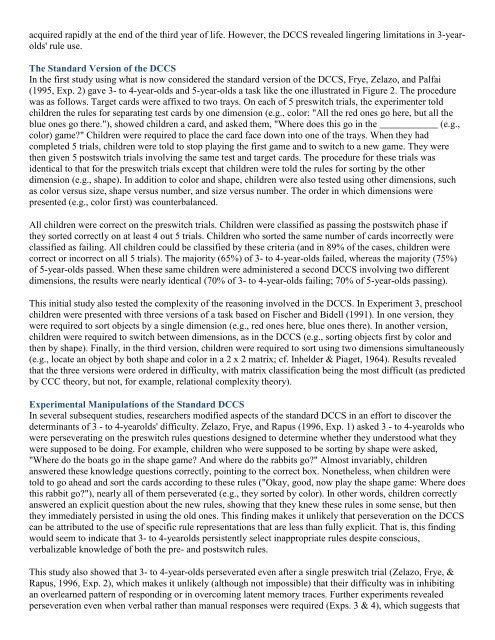THE DEVELOPMENT OF EXECUTIVE FUNCTION IN EARLY ...
THE DEVELOPMENT OF EXECUTIVE FUNCTION IN EARLY ...
THE DEVELOPMENT OF EXECUTIVE FUNCTION IN EARLY ...
Create successful ePaper yourself
Turn your PDF publications into a flip-book with our unique Google optimized e-Paper software.
acquired rapidly at the end of the third year of life. However, the DCCS revealed lingering limitations in 3-yearolds'<br />
rule use.<br />
The Standard Version of the DCCS<br />
In the first study using what is now considered the standard version of the DCCS, Frye, Zelazo, and Palfai<br />
(1995, Exp. 2) gave 3- to 4-year-olds and 5-year-olds a task like the one illustrated in Figure 2. The procedure<br />
was as follows. Target cards were affixed to two trays. On each of 5 preswitch trials, the experimenter told<br />
children the rules for separating test cards by one dimension (e.g., color: "All the red ones go here, but all the<br />
blue ones go there."), showed children a card, and asked them, "Where does this go in the ____________ (e.g.,<br />
color) game?" Children were required to place the card face down into one of the trays. When they had<br />
completed 5 trials, children were told to stop playing the first game and to switch to a new game. They were<br />
then given 5 postswitch trials involving the same test and target cards. The procedure for these trials was<br />
identical to that for the preswitch trials except that children were told the rules for sorting by the other<br />
dimension (e.g., shape). In addition to color and shape, children were also tested using other dimensions, such<br />
as color versus size, shape versus number, and size versus number. The order in which dimensions were<br />
presented (e.g., color first) was counterbalanced.<br />
All children were correct on the preswitch trials. Children were classified as passing the postswitch phase if<br />
they sorted correctly on at least 4 out 5 trials. Children who sorted the same number of cards incorrectly were<br />
classified as failing. All children could be classified by these criteria (and in 89% of the cases, children were<br />
correct or incorrect on all 5 trials). The majority (65%) of 3- to 4-year-olds failed, whereas the majority (75%)<br />
of 5-year-olds passed. When these same children were administered a second DCCS involving two different<br />
dimensions, the results were nearly identical (70% of 3- to 4-year-olds failing; 70% of 5-year-olds passing).<br />
This initial study also tested the complexity of the reasoning involved in the DCCS. In Experiment 3, preschool<br />
children were presented with three versions of a task based on Fischer and Bidell (1991). In one version, they<br />
were required to sort objects by a single dimension (e.g., red ones here, blue ones there). In another version,<br />
children were required to switch between dimensions, as in the DCCS (e.g., sorting objects first by color and<br />
then by shape). Finally, in the third version, children were required to sort using two dimensions simultaneously<br />
(e.g., locate an object by both shape and color in a 2 x 2 matrix; cf. Inhelder & Piaget, 1964). Results revealed<br />
that the three versions were ordered in difficulty, with matrix classification being the most difficult (as predicted<br />
by CCC theory, but not, for example, relational complexity theory).<br />
Experimental Manipulations of the Standard DCCS<br />
In several subsequent studies, researchers modified aspects of the standard DCCS in an effort to discover the<br />
determinants of 3 - to 4-yearolds' difficulty. Zelazo, Frye, and Rapus (1996, Exp. 1) asked 3 - to 4-yearolds who<br />
were perseverating on the preswitch rules questions designed to determine whether they understood what they<br />
were supposed to be doing. For example, children who were supposed to be sorting by shape were asked,<br />
"Where do the boats go in the shape game? And where do the rabbits go?" Almost invariably, children<br />
answered these knowledge questions correctly, pointing to the correct box. Nonetheless, when children were<br />
told to go ahead and sort the cards according to these rules ("Okay, good, now play the shape game: Where does<br />
this rabbit go?"), nearly all of them perseverated (e.g., they sorted by color). In other words, children correctly<br />
answered an explicit question about the new rules, showing that they knew these rules in some sense, but then<br />
they immediately persisted in using the old ones. This finding makes it unlikely that perseveration on the DCCS<br />
can be attributed to the use of specific rule representations that are less than fully explicit. That is, this finding<br />
would seem to indicate that 3- to 4-yearolds persistently select inappropriate rules despite conscious,<br />
verbalizable knowledge of both the pre- and postswitch rules.<br />
This study also showed that 3- to 4-year-olds perseverated even after a single preswitch trial (Zelazo, Frye, &<br />
Rapus, 1996, Exp. 2), which makes it unlikely (although not impossible) that their difficulty was in inhibiting<br />
an overlearned pattern of responding or in overcoming latent memory traces. Further experiments revealed<br />
perseveration even when verbal rather than manual responses were required (Exps. 3 & 4), which suggests that
















